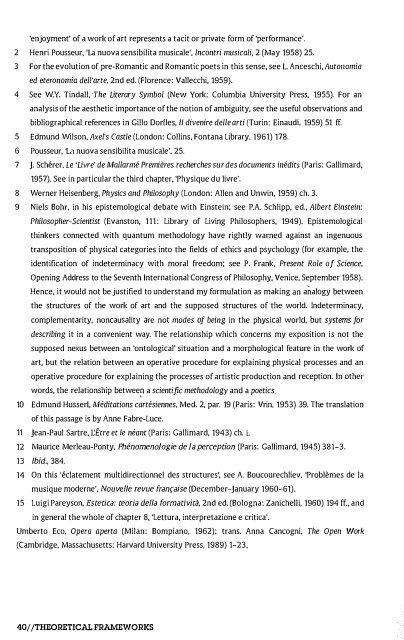You also want an ePaper? Increase the reach of your titles
YUMPU automatically turns print PDFs into web optimized ePapers that Google loves.
'enjoyment' of a work of art represents a tacit or private form of 'performance'.<br />
2 Henri Pousseur, 'La nuova sensibilita musicale', Incontri musicali, 2 (May 1958) 25.<br />
3 For the evolution of pre-Romantic and Romantic poets in this sense, see L Anceschi, AutorlOmia<br />
ed eteronomia dell'arte, 2nd ed. (Florence: Vallecchi, 1959).<br />
4 See W.Y. Tindall, 'The Literary Symbol (New York: Columbia University Press, 1955). For an<br />
analysis of the aesthetic importance of the notion of ambiguity, see the useful observations and<br />
bibliographical references in Gillo Dorfles, II divenire delle arti (Turin: EinaudL 1959) 51 ff.<br />
5 Edmund Wilson, Axel's Castle (London: Collins, Fontana Library, 1961) 178.<br />
6 Pousseur, 'Ll nuova sensibilita musicale', 25.<br />
7 J. Scherer, Le 'Livre' de Mallarme Premieres recherches sur des documents inedits (Paris: Gallimard,<br />
1957). See in particular the third chapter, 'Physique du livre'.<br />
8 Werner Heisenberg, Physics and Philosophy (London: Allen and Unwin, 1959) ch. 3.<br />
9 Niels Bohr, in his epistemological debate with Einstein; see P.A. Schlipp, ed., Albert Einstein:<br />
Philosopher-Scientist (Evanston, 111: Library of Living Philosophers, 1949). Epistemological<br />
thinkers connected with quantum methodology have rightly warned against an ingenuous<br />
transposition of physical categories into the fields of ethics and psychology (for example, the<br />
identification of indeterminacy with moral freedom; see P. Frank. Present Role of Science,<br />
Opening Address to the Seventh International Congress of Philosophy, Venice, September 1958).<br />
Hence, it would not be justified to understand my formulation as making an a � alogy between<br />
the structures of the work of art and the supposed structures of the world. Indeterminacy,<br />
complementarity, noncausality are not modes Of being in the physical world, but systems fo r<br />
describing it in a convenient way. The relationship which concerns my exposition is not the<br />
supposed nexus between an 'ontological' situation and a morphological feature in the work of<br />
art, but the relation between an operative procedure for explaining physical processes and an<br />
operative procedure for explaining the processes of artistic production and reception. In other<br />
words, the relationship betwee � a scientific methodology and a poetics.<br />
10 Edmund Husser!, Meditations cartesiennes, Med. 2, par. 19 (Paris: Vrin, 1953) 39, rile translation<br />
of this passage is by Anne Fabre-Luce.<br />
11 Jean-Paul Sartre, VEtre et Ie neant (Paris: Gallimard, 1943) ch. i.<br />
12 Maurice Merleau-Ponty, Phenomenoiogie de fa perception (Paris: Gal!imard, 1945) 381-3.<br />
13 Ibid., 384.<br />
14 On this 'eclatement multidirectionne! des structures', see A. Boucourechliev, 'Problemes de la<br />
musique moderne', Nouvelle revue franraise (December-January 1960-61).<br />
15 Luigi Pareyson, Estetica: teoria della formativita, 2nd ed. (Bologna: ZanicheHi, 1960) 194 ff., and<br />
in general the whole of chapter 8, 'Lettura, interpretazione e critica'.<br />
Umberto Eco, Opera aperta (Milan: Bompiano, 1962); trans. Anna Cancogni. The Open Work<br />
(Cambridge, Massachusetts: Harvard University Press, 1989) 1-23.<br />
401lTHEORETICAL FRAMEWORKS








